- Retour accueil
- Vous êtes ici : Blog The Great Pyramid of Khufu Akhenaten and Nefertiti represented themselves as Shu and Tefnut, the deities that combined together created the evaporative cooling in the Great Pyramid of Khufu ©2021
Akhenaten and Nefertiti represented themselves as Shu and Tefnut, the deities that combined together created the evaporative cooling in the Great Pyramid of Khufu ©2021
Publié par Bruno Coursol dans The Great Pyramid of Khufu le 02/12/2021 à 14:49

King Akhenaten was an ancient Egyptian pharaoh of the Eighteenth Dynasty who abandoned Egypt's traditional polytheism for Atenism, a worship centered around one single god : Aten. But at the same time, Akhenaten represented himself as god Shu, and his wife Nefertiti as the ancient Egyptian goddess Tefnut. After Akhenaten's death, his son Tutankhamen restored the ancient traditional polytheism.
Akhenaten 's name meaning was "Effective for the Aten". Reigning about 17 years, between 1353 and 1336 BCE, or between 1351 and 1334 BCE, he was the tenth ruler of Dynasty 18. Before the fifth year of his reign, he was known as Amenhotep IV (Ancient Egyptian: jmn-ḥtp, meaning "Amun is satisfied").
King Akhenaten from tutincommon on flickr and bust of Queen Nefertiti from the Ägyptisches Museum Berlin collection, presently in the Neues Museum and photographed by Philip Pikart : https://en.wikipedia.org/wiki/Nefertiti#/media/File:Nofretete_Neues_Museum.jpg
Drawing of Shu by Jeff Dahl : https://en.wikipedia.org/wiki/Shu_(Egyptian_god)#/media/File:Shu_with_feather.svg
Drawing of Tefnut by A8takashi : https://en.wikipedia.org/wiki/Tefnut#/media/File:Tefnut.png
The misleading theory of the monotheism of Akhenaten's religious changes
For those who are tired of hearing about ancient Egyptian gods Shu and Tefnut, I'm afraid that you are gonna have to endure some more, because if most people know that Akhenaten pretty much wiped out every single god of his ancestors, few probably know that Akhenaten represented himself as god Shu and his wife Nefertiti as goddess Tefnut.
It looks like all the attention on the changes made by Akhenaten on the Egyptian religion, was directed towards Aten, the Solar disc god ; but I think we got mislead : what we should have focus ourselves on, was Shu and Tefnut.
I understand that egyptologists didn't want to talk about anything else than Aten, because if they would have try to explain why a pharaoh and his wife were depicting themselves as gods, they would probably have to rethink everything about ancient Egyptian religion.
Representing ourselves as god is a pretty strong statement, don't you think? Some could even say it is a huge political statement.
To this day, both the French and English Wikipedia's pages about Akhenaten don't even mention that fact*. The least we can do is talk about it.
Additionally to Shu and Tefnut, Akhenaten also liked to represent the Ankh sign, a symbol I just couldn't figure out exactly until I started to work on this heretic king.
Shu, Tefnut and the Ankh symbol are linked together, and I will try to demonstrate in this article that it is Akhenaten and Nefertiti who are giving the Ankh symbols to the Aten solar disc, and not them who are receiving the Ankhs ; and that the meaning of this Ankh symbol isn't "life" or "breath of life", but "cold air".
*In the entire English Wikipedia's page on Akhenaten (a document of about 10575 words, according to http://compteur-de-mots.net/), the word "Shu" appears 2 times, but only in a discussion about Aten's name ; and the total amount of times that "Tefnut" is written in the page about Nefertiti… is zero (copy-paste the text in Word and use the Research function, for example).
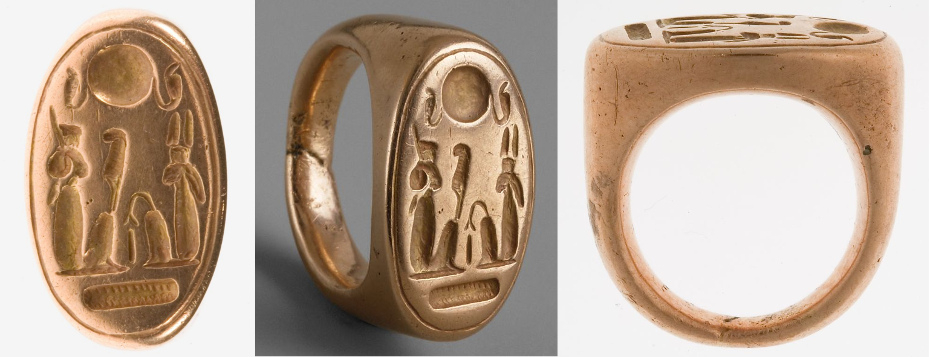
Finger Ring depicting King Akhenaten and Queen Nefertiti as Shu and Tefnut from the Metropolitan Museum of Art. New Kingdom, Amarna Period, ca. 1353–1336 BC. Accession Number : 26.7.767. https://www.metmuseum.org/art/collection/search/544679
Excerpt from the MET data sheet : "This ring was found at Amarna. The hieroglyphs may be read as an ideogram. The two seated figures are probably Akhenaten (left) and Nefertiti (right) as the deities Shu (air as indicated by the feather he holds) and Tefnut (moisture)".
Akhenaten represented himself as god Shu and Nefertiti as goddess Tefnut
It is often said that Akhenaten rejected every ancient Egyptian god and that the cult of Aten was monotheist, but it isn't exact : Shu and Tefnut were saved.
Not only Shu and Tefnut were the only deities that Akhenaten didn't reject when he decided to reject all the other ancient deities, but surprisingly he decided that he would himself be depicted as god Shu, and his wife Nefertiti as the goddess Tefnut.
"During the “Aten heresy” led by Akhenaten, Shu, and Tefnut remained popular with the apparently monotheistic pharaoh. The pharaoh and his queen (Nefertiti) were depicted as the personification of Shu and Tefnut emphasising their divinity. As the Aten represented the sun disk, the solar aspect of Shu and his link with the pharaoh apparently prevented Shu from being proscribed along with Amun and the other gods." https://ancientegyptonline.co.uk/shu/
"Even on the pharaoh's own stone sarcophagus, images of Nefertiti replaced those of traditional goddesses. Akhenaten, by associating himself with Shu and the Aten, and Nefertiti with Tefnut, had effectively presented himself and his family as living gods." https://www.worldhistory.org/article/1110/the-art-of-the-amarna-period/
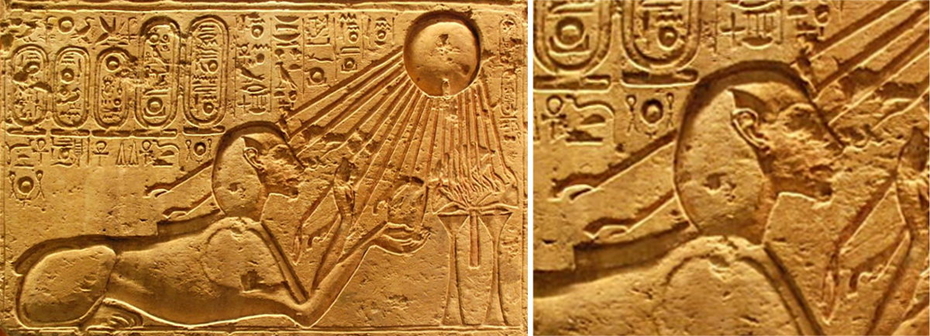
King Akhenaten worshiping Aten. Please notice the Ankh sign pointed towards the nose of Akhenaten as a sphinx. Source : Echnaton (Akhenaten) as Sphinx. From Amarna. Kestner Museum, Hannover. Photographed by Hans Ollermann on flickr : https://www.flickr.com/photos/menesje/2212492438/
The Akhenaten sphinx basking in the Aten Sun : beams are about heat, not light
This image showing King Akhenaten in the form of a sphinx is maybe one of the best representations of the real meaning of the sun Aten.
It is said that Aten is radiating beams of light, but the position of the sphinx is telling us another story : he is depicted resting on the ground with the sun beams all around him, back included, and these beams have hands at their ends.
Hands are made for touching, so the solar beams are "touching" the sphinx but also all the scenery around him : they are not light beams but they are transmitting the heat radiating from the Solar disc Aten and they are "petting" the sphinx who is basking in the sun.
"Shu is thus not only "air which is in the sun", but also, according to Akhenaton's religion, "heat which is in Aton". Egyptian Myths And Legend, By Donald Mackenzie
Aten is a representation of the heat, and in my opinion it is just here to emphasize Akhenaten's role/performance/demonstration into cold production.
Aten is not shown with beams of light emanating from him : he is radiating heat.
If Akhenaten is receiving the Ankh symbols of life from Aten because of the hands at the end of the Solar beams, why is there also hands on every single beam, whether they are directed towards Akhenaten/Nefertiti or not ?
Hands are not giving the Ankh symbols, they are taking them from Akhenaten and Nefertiti.
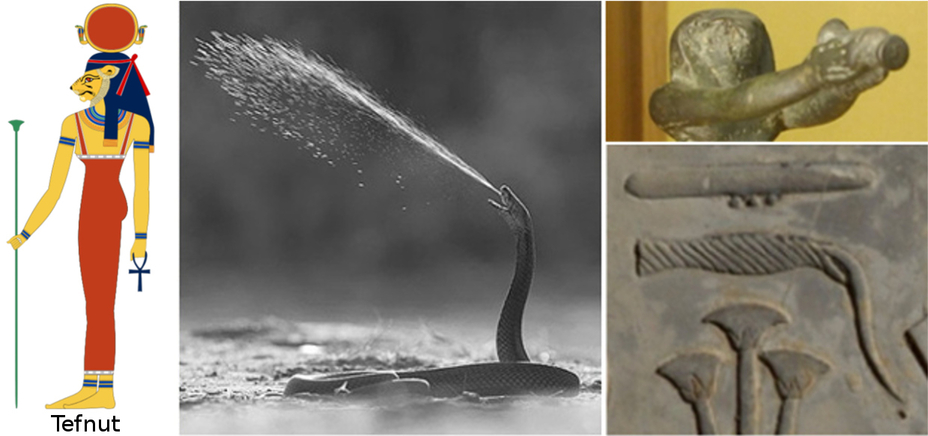
It is the association of dry warm air (personified as god Shu) and spat water (the goddess Tefnut), that was producing the cold in the horizontal passage of the Great Pyramid, by evaporative cooling.
Goddess Tefnut isn't a representation of any kind of water : she stands for spat water, that is water in form of liquid droplets
Tefnut isn't a representation of any kind of water : it is not about the water from the Nile (that is represented with god Hapi), or water from the ocean or water to drink : Tefnut is representing spat water, that is water in form of liquid droplets, whether it is dew drops, or rain drops or even tinier drops that are responsible for moisture and humid air.
This water spitting thing is so important that this is even represented in her name.
"Tefnut (tfnwt) is a deity of moisture, moist air, dew and rain in Ancient Egyptian religion."
"Literally translating as "That Water", the name Tefnut has been linked to the verb 'tfn' meaning 'to spit' and versions of the creation myth say that Ra (or Atum) spat her out and her name was written as a mouth spitting in late texts." https://en.wikipedia.org/wiki/Tefnut
God Shu isn't a representation of any kind of air : he stands for dry and warm air but also fog
"The ancient Egyptian god Shu is represented as a human with feathers on his head, as he is associated with dry and warm air." [...]
"Fog and clouds were also Shu's elements" https://en.wikipedia.org/wiki/Shu_(Egyptian_god)
"Shu is thus not only "air which is in the sun", but also, according to Akhenaton's religion, "heat which is in Aton". Egyptian Myths And Legend, By Donald Mackenzie

It is the association of dry warm air (personified as god Shu) and spat water in the form of droplets (the goddess Tefnut), that is producing the fog of cold in the horizontal passage of the Great Pyramid of Khufu.
King Akhenaten and Nefertiti were creating cold air : that is the meaning of the Ankh symbol
If it is Akhenaten/Shu (meaning the dry warm air) and Nefertiti/Tefnut (meaning the spat water in the form of droplets) who are giving the Ankh symbols to the Solar disc Aten, then it means that the Ankh symbol is what comes out of the association of Shu and Tefnut : cold air.
The Ankh is the symbol of cold air, an element that is processed through the nose and that explains why Akhenaten and Nefertiti are expelling Ankh symbols through the nose : they are expelling cold air through the nose.
The hands at the end of the Solar beams are not meant to grab something (exception made of the Ankhs generated by Akhenaten and Nefertiti), they are here to emphasize the fact that these beams were touching things and people. The beams are representing the heat of the Solar disc Aten, and only Akhenaten and Nefertiti themselves would be able to respond to it, with the cold air : the Ankh symbols.
Akhenaten rejected everything about HOW was produced the cold, and HOW it will be used
It is like Akhenaten decided to forget and disprove every part of ancient religion that referred to how was created the cold : all the gods referring to the Grand Gallery (like Ptah, Sokar, Osiris, Aker...) or the Great Serpent Apep of the inclined well or even Nefertem and its fog nozzle in the horizontal passage. But he also wasn't interested in how it will be used in the Solvay process cooling (Horus, Isis, Nephthys, Seth...).
In other words, Akhenaten wanted to concentrate its worship on the central part of his ancestors work, the magical part of the entire Solvay manufacturing : the cold and the chemical manufactured products of the Solvay process itself.
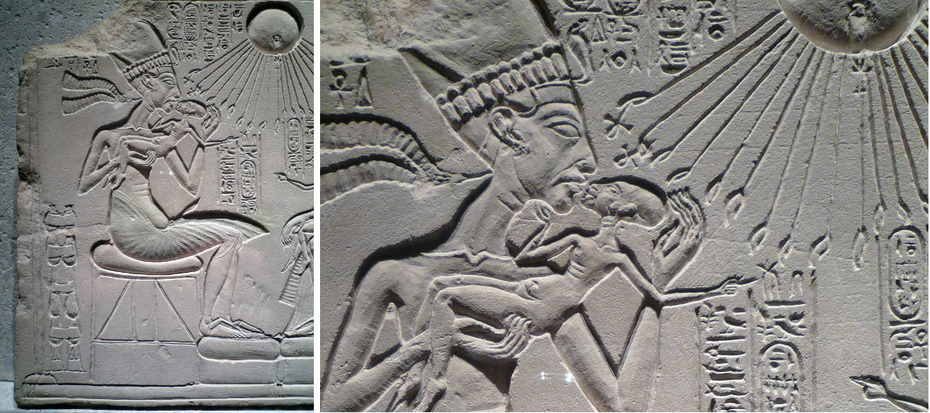
Detail (showing Akhenaten) of the relief of King Akhenaten (Akhenaton) and Queen Nefertiti, in the State Museums at Berlin : King Akhenaton (left) with his wife, Queen Nefertiti, and three of their daughters under the rays of the sun god Aton, altar relief, mid-14th century BCE. Photographed by Steven Zucker and posted on flickr, https://www.flickr.com/photos/profzucker/7670416780/in/photostream/
The Ankh is the symbol of the evaporative cooling
Akhenaten and his wife Nefertiti represented themselves as god Shu and goddess Tefnut, the deities that combined together created the evaporative cooling in the Great Pyramid of Khufu.
In other words, Akhenaten and Nefertiti wanted to be seen as the ones creating the magical cold, and that is what they are giving to the heat of the solar rays : the ankh symbol is the cold.
Please note on this State Museums at Berlin's relief, that both Akhenaten (above photograph) and Nefertiti (photograph below) have Ankh signs next to their noses. These Ankhs aren't given to them by Aten, but it is they, Akhenaten and Nefertiti who are giving the Ankh symbols : they are offering the cold.
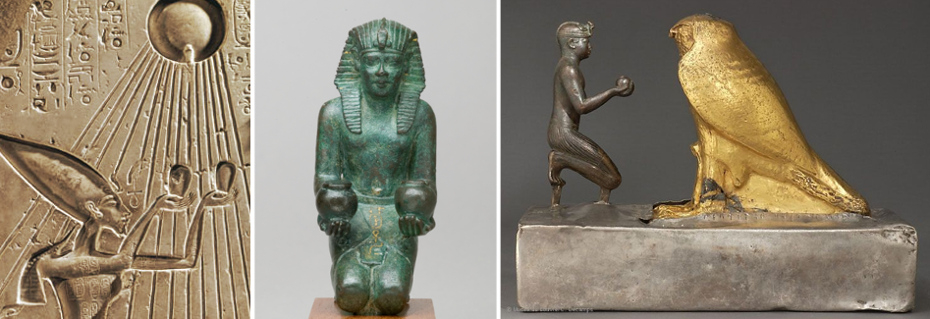
Kneeling statuette of King Amasis, from the Metropolitan Museum of Art, New-York. Accession Number: 35.9.3 ; 570–526 B.C. (center image).
Pharaoh king Taharqa "presenting god Hemen with wine" E25276 from the Louvre Museum, Paris (right image).
This amazing artifact from the Louvre Museum is outstanding, because it shows a pharaoh kneeled down in front of the representations of the heat generated by the chemical manufacturing (the falcon) and the cold production (the snake), both put on the representation of the impactor of the grand gallery / inclined well : the wooden hollow base of the figure.
Akhenaten only changed the rules, not the game
"During the Amarna Period (1353 - 1336 BCE), when Akhenaten banned the cult of Amun along with the rest of the gods and raised the god Aten as the sole god of Egypt, the ankh sign continued in popular use. The symbol is seen in paintings and inscriptions at the end of the beams of light emanating from the solar disc of Aten, bringing life to those who believe." https://www.worldhistory.org/Ankh/
This excerpt from worldhistory.com is particularly interesting : the academic interpretation is that the ankh sign is given by Aten to Akhenaten and Nefertiti.
But I disagree. In my opinion, this scene has to be interpreted in the exact same way as the one with pharaoh Amasis and his two jars, on the above photograph.
King Amasis was following the tradition : he was worshiping the entire story of his ancestors and he was demonstrating that the chemical manufacturing of sodium carbonate and sodium bicarbonate by the Solvay process was successful.
King Akhenaten doesn't want to continue worshiping non important gods, he doesn't care about the technical part of the process, he just cares about the cold and he wants to be associated with it.
The cold is the only thing you need to complete the Solvay process.
The evaporative cooling is the transformation of dry warm air into cold air, using water in form of droplets, but the key is air. The cooling is producing cold air. And air is processed through the nose.
Akhenaten not only wanted to show that he was successfully able to manufacture the Solvay products, but he also wanted to demonstrate that he was creating the cold.
King Akhenaten is represented giving the 2 jars containing sodium carbonate and sodium bicarbonate to the Aten Solar disc, but he is also represented breathing cold air.
The meaning of Akhenaten's name is "Effective for the Aten" : it suggests that he was supposed to produce something
The idea that Akhenaten is depicted giving something to Aten, instead of the opposite, is actually suggested in his name : the meaning of Akhenaten is "Effective for the Aten". And that was also true for the first 5 years of his reign when his name was Amenhotep IV, from the ancient Egyptian: jmn-ḥtp, meaning "Amun is satisfied".
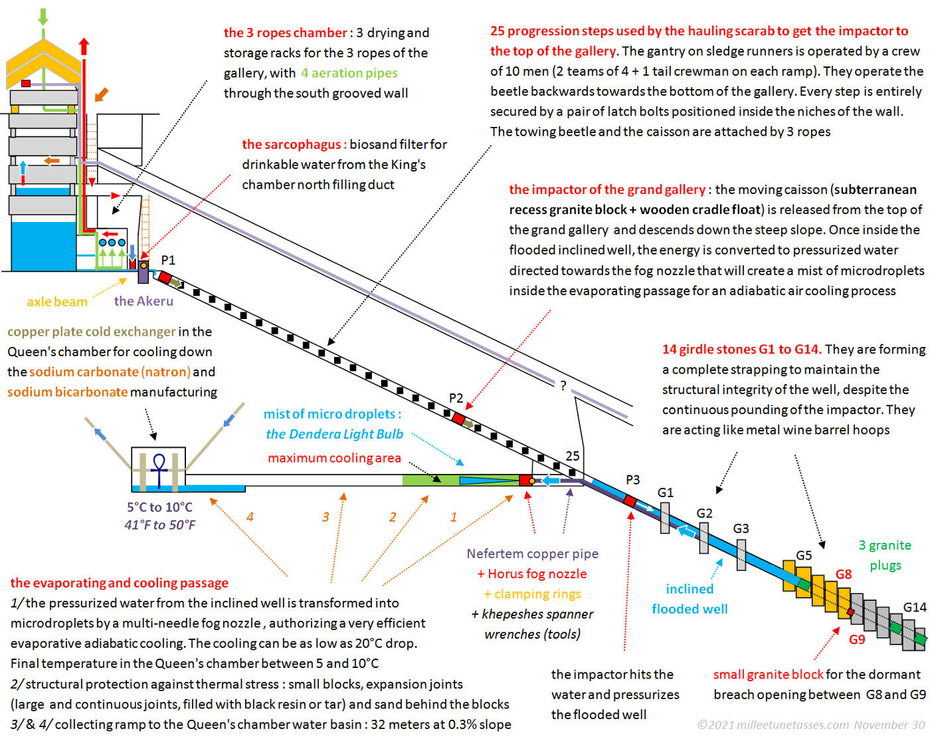
The Great Pyramid of Khufu operating diagram for the cooling of chemical manufacturing of sodium carbonate and sodium bicarbonate by the Solvay process. Updated November 30, 2021.
Imhotep's "Refreshment of the Gods" Pyramid : the solution was here from the very beginning
Imhotep biggest influence was not in the medicine field, but in architecture. He is the one who built the first true pyramid in ancient Egypt, made of stone blocks and not dried mud bricks : the Djoser's Step Pyramid. Interestingly, this unprecedented step pyramid was called "The Refreshment of the Gods" ; and that obviously echoes the evaporative cooling process used in the Great Pyramid.
My conviction is that the term "refreshment" is not fully accurate: Imhotep's first pyramid was certainly not the "refreshment pyramid", but "the Pyramid of the cold".
Ancient Egyptians didn't master an ammonia Solvay-like process overnight : it had to be a long experimental journey, over many generations (the Disc of Sabu is dated from the First Dynasty, 3100 BCE to 3000 BCE ; and the Djed Pillars from even before that). Most probably, their biggest challenge from the beginning was cooling down the reaction chambers.
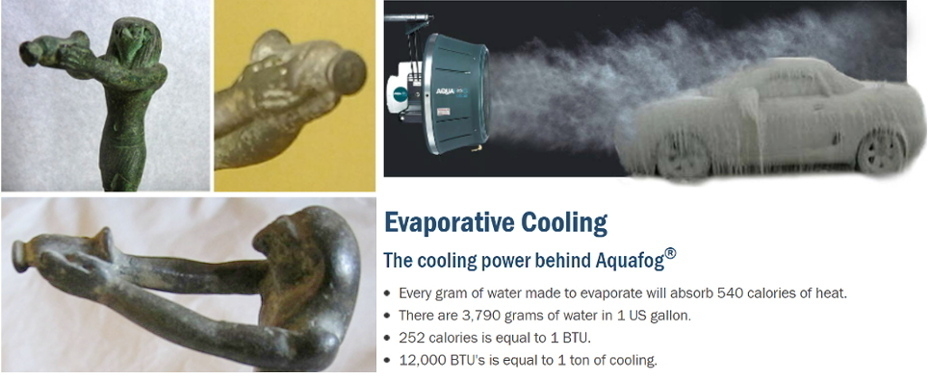
The ancient Egyptian god Horus, holding the fog nozzle of the evaporative cooling passage of the Great Pyramid.
Horus images : E3752 from the Louvre Museum and figurine of Horus DUT162 also from the Louvre Museum ; Paris, France, Hauteur : 9 cm ; Largeur : 2,7 cm ; Profondeur : 6 cm. Date de création/fabrication : Basse Epoque (664 - 332 BCE).
Evaporative cooling applications webpage screenshot : AquaFog® from Jaybird Manufacturing Inc (Pennsylvania, USA).
The surprising efficiency of the evaporative cooling process that created cold in the horizontal passage of the Great Pyramid of Khufu, is still used today in modern evaporative coolers
"Evaporative coolers lower the temperature of air using the principle of evaporative cooling, unlike typical air conditioning systems which use vapor-compression refrigeration or absorption refrigeration. Evaporative cooling is the conversion of liquid water into vapor using the thermal energy in the air, resulting in a lower air temperature". Source : https://en.wikipedia.org/wiki/Evaporative_cooler
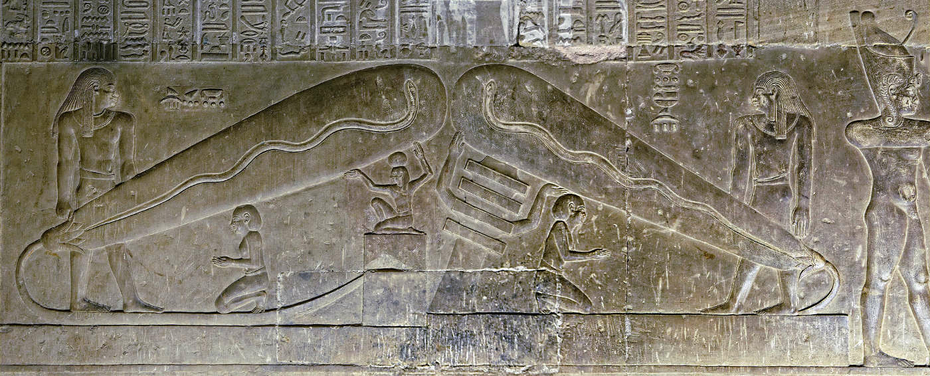
Dendera Light Bulb relief in the Hathor temple. Please note that the small character holding the left Dendera Lamp Bulb, with his arms in the air, is Shu, the god of dry warm air and fogs. Photographed by kairoinfo4U and posted on flickr : https://www.flickr.com/photos/manna4u/14525094039/
The Dendera Light Bulb is the fog of microdroplets spat out of the fog nozzle in the horizontal passage of the Great Pyramid
On the Dendera Light reliefs, the theoretical part of the basic principle is carved on the left side of the relief : the character is offering the fog (the cold) ; and the practical application is on the right of the relief with the use of the cold for the counterflow chemical reaction tower (the Djed Pillar), through the 2 shafts of the Queen's chamber (the arms of the relief).
The double outline of the 2 characters holding and offering the Dendera Light Bulb, is the proof that the bulb was producing cold. They were cold themselves and they were represented having the goose bumps.

Dendera Light Bulb relief details, in the Hathor temple. Photographed by kairoinfo4U and posted on flickr : https://www.flickr.com/photos/manna4u/14525094039/
The "double outline" of the character producing and offering the Dendera Light fog of cold
This "double outline" isn't discussed at all by anybody, though it is the most important element of the Dendera reliefs. The fog is made of microdroplets of liquid water and it would evaporate itself, taking the necessary energy from the air. The result is the cooling down of the air. The character is offering cold, and he is cold himself.
The "double outline" of the offering fog character of the Dendera Light reliefs, shows the goose bumps. He was cold himself.
The "Power of Water" and the "Bristling Hair" reference in the Book of the Dead of Ani
That double outline of the Dendera relief character, being a representation of the goose bumps that results of cold temperatures induced by the association of air and water, is actually present in the Egyptian Book of the Dead of Ani.
The following excerpt comes from the papyrus of Ani, Egyptian Book of the Dead (240 BCE), translated by E.A. Wallis Budge (last third of the page) : http://www.ancienttexts.org/library/egyptian/bookodead/book5.htm
"The Chapter Of Breathing The Air And Of Having Power Over Water in Khert-Neter."
"The Osiris Ani saith: Open to me! Who art thou? Whither goest thou? What is thy name? I am one of you. Who are these with you? The two Merti goddesses (Isis and Nephthys). Thou separatest head from head when [he] entereth the divine Mesqen chamber. He causeth me to set out for the temple of the gods Kem-heru. "Assembler of souls" is the name of my ferry-boat. "Those who make the hair to bristle" is the name of the oars. "Sert" ("Goad") is the name of the hold. "Steering straight in the middle" is the name of the rudder; likewise, [the boat] is a type of my being borne onward in the lake. Let there be given unto me vessels of milk, and cakes, and loaves of bread, and cups of drink, and flesh, in the Temple of Anpu."

Dendera Light relief drawing on the left : please notice that what seems to be important here isn't the snake, but the spat venom of the snake. Also, you can see that the characters holding the snake are showing a double outline, the same way that the character holding (or offering) the Dendera Light does, on the right part of the drawing. The Dendera Light is produced by the snake, or as explained : by the venom of the snake. This particular relief is describing how was produced the microdroplets fog of sprayed water. Dendera Light drawing from the New York Public Library (Digital Collections). Author : Auguste Mariette, 1821-1881
The name of the serpent goddess of embalming liquid Kebechet "that refreshes and purifies the pharaoh" means literally "cooling water" (bottom right golden artifact)
This idea of a serpent representing water and cold, involved in the mummification process (the natron is the salt used for this occasion), and that progressively emerged from my work, is actually a genuine one, and she has a name : goddess Kebechet.
Wikipedia : "In Egyptian mythology, Kebechet (also transliterated as Khebhut, Kebehut, Qébéhout, Kabehchet and Kebehwet) is a goddess, a deification of embalming liquid."
"Her name means cooling water" and "in the Pyramid Texts, Kebechet is referred to as a serpent who "refreshes and purifies" the pharaoh...". Also : "Kebechet was thought to give water to the spirits of the dead while they waited for the mummification process to be complete."
On this artifact of Kebechet, my interpretation is the following : the snake represents the entire sequence of the pressurized water spat out of the inclined well. The tail of the snake is the section of the well involved in the process, its body is the horizontal passage and its head is the fog nozzle. The structure on which the snake is put, is the horizontal passage itself, and it ends just after the step, before the entry to the Queen's chamber.
The venom spray of a spitting snake : the fog of microdroplets
In my theory, the ascending passage of the Great Pyramid, is flooded and the fall of an impactor (wooden cradle float + granite block), pressurizes the ascending passage (the inclined well) and so generates high-pressurized water that is sprayed inside the horizontal passage into a fog of microdroplets using the principle of a modern fog nozzle. The liquid water, spat out of the nozzle, instantly vaporizes itself and by doing so, cool down the air temperature.
This is an adiabatic evaporative cooling process, that can cool down the air very effectively, with a 15 to 20°C drop.
That fog of liquid water microdroplets, is the Dendera Light.
The above drawing of one of the Dendera Light reliefs, is absolutely outstanding, because it is organized the same way we do today in every single science book : the theoretical part on one side and the practical part on the other side.
On the left side of the drawing, we can see that the key element is the spat venom of the snake and not the snake by itself : that represents the sprayed water ; and on the right side we can see the practical application of the concept inside the horizontal passage of the Great Pyramid : from the inclined well (the ascending passage), is the water pipe going to the fog nozzle and resulting in the microdroplets fog.
Please note that 1/ the angle of the Dendera Light Bulb is very similar to the angle of the typical venom spray of a spitting snake ; and 2/ the shape of the Light Bulb is very similar to the shape of the horizontal passage.

The horizontal cooling passage of the Great Pyramid of Khufu. Updated December 1, 2021. The fine sand lining has only been discovered in the first part of the passage, the question is to know how extended was that thermal insulation (hence the question marks).
Elevation data (inches) : "The pyramids and temples of Gizeh", by Petrie, W. M. Flinders (William Matthew Flinders), Sir, 1853-1942 ; "Passage to Queen's Chamber" (section 40, page 66) : https://archive.org/details/cu31924012038927/page/n103/mode/2up
The horizontal evaporative cooling passageway inside the Great Pyramid of Khufu
The horizontal passage was an evaporating cooling unit for the sodium carbonate (natron) Na2CO3 production by a soda-ash ammonia Solvay process. The key element of the passage was a multi-needle fog nozzle, very similar to modern firefighter nozzles. The nozzle transformed the pressurized water coming from the inclined well into a fog of liquid microdroplets that would evaporate in the passage and cool down the air between 5°C and 10°C.
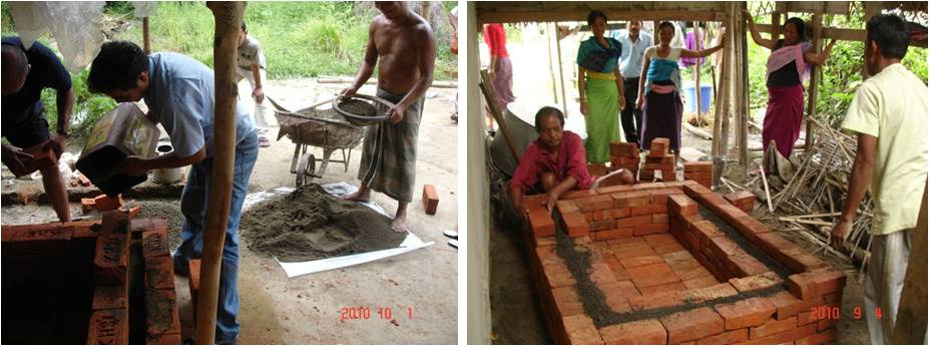
The use of wet sand as thermal insulation, in the construction of cool chambers. Left : Construction of Zero Energy Cool Chamber at Thoubal district, Manipur (India). Right : same thing but at Karong Village.
The Zero Energy cool chamber sand of the horizontal passage of the Great Pyramid of Khufu
The idea that the horizontal passage of the Great Pyramid was designed as a part of a cooling unit, is reinforced by the fact that fine sand was found behind some blocks of the passage.
If my theory is right, then that same sand would have been probably set all around the entire structure [horizontal passage + Queen's chamber] ; exactly like it is shown on the above photographs of the construction of Zero Energy Cool Chambers, in India.
After all, when the French team who discovered the sand behind the blocks, reported it, they were asked to stop their work. We don't know the entire extend of the sand casing behind the blocks.
I first thought the sand was here to reduce the thermal stress on the structure, due to the constant sudden changes in temperature that occurred in the first part of the passage, and maybe it also served this problem ; but it was most likely to be essentially a thermal insulation.
The Dormion and Goidin discovery on the fine sand lining of the horizontal passage of the Great Pyramid
Excerpt from the Los Angeles Times article "Scientists Seeking Hidden Vaults in Great Pyramid Find Only Sand", written by Michael Ross, September 1986 : https://www.latimes.com/archives/la-xpm-1986-09-09-mn-12810-story.html

"A team of French scientists searching for hidden, treasure-filled rooms in the Great Pyramid of Cheops suspended work Monday after drilling three holes through an interior wall and finding only sand. But the French team and the head of the Egyptian organization supervising the work said they believe that the presence of a powder-fine lining of sand between the interior stones of the Great Pyramid supports their theory that secret chambers lie deep within the 4,600-year-old tomb of the Pharaoh Cheops.
“The sand means the ancient Egyptians are protecting something, something very serious and meaningful,” said Ahmed Kadry, head of the Egyptian Antiquities Organization. He said that although the French team failed to find and penetrate the cavities, samples taken from the wall beyond the sand lining indicate that it is made of a fine, soft limestone used by the ancient Egyptians for ornamental carvings on royal tombs.
“We can be sure now that there are cavities, and not just structural or stress cavities but something much more mysterious,” he said.
The French mission, headed by Gilles Dormion and Jean-Patrice Goidin, two architects who postulated the existence of secret rooms in the Great Pyramid on the basis of architectural anomalies in the interior stonework, had hoped to bore four holes through the wall of a gallery leading to the so-called Queen’s chamber. The plan then was to observe and photograph the interior with an endoscope, an optical instrument developed for viewing the interior of human organs.
However, the work was suspended after five days when, after boring three holes through more than eight feet of hard limestone, the drills hit the fine sand lining. Jacques Montlucon, an engineer with the French National Electric Company, which is providing technical expertise for the project, said the work was suspended because the drills being used are not suitable to bore through sand.
The existence of hidden chambers in the Great Pyramid has long been suspected, but there was never any real evidence until last May, when the French found what they said appeared to be three spaces, measuring 6 feet by 9 feet, off of the Queen’s gallery. The discovery, which the French said could indicate the presence of hidden storerooms, created a flurry of excitement among Egyptologists, who for the most part have assumed that all the treasures of Cheops were plundered long ago.
Not all the experts share Kadry’s conviction that there are secret chambers, but discovery of a sand lining about 10 to 17 inches thick between the great stones is regarded as a puzzling and exciting find in itself."
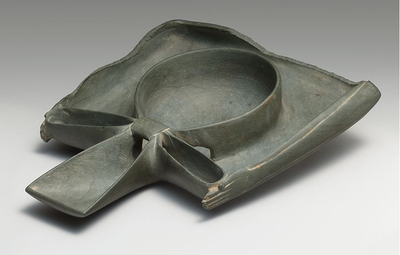
Libation Dish Depicting Ka-Arms Presenting an Ankh-Signca. Early Dynastic Period, 3100–2900 B.C. Medium: Greywacke. Metropolitan Museum of Art, New-York. Accession Number: 19.2.16.
https://www.metmuseum.org/art/collection/search/543866
From the Museum data sheet : "This masterpiece of Early Dynastic stone carving has the shape of two intricately linked hieroglyphs. The two bent arms that frame three sides of the dish are read "ka," the word for "spirit" in ancient Egyptian. The loop and knot are read "ankh," meaning "life," or "to live." The combination could be interpreted as the phrase "life to thy spirit" or as the name of a person, Ankh-ka. The dish was undoubtedly used to pour a purifying liquid, probably water, that would take on the magical significance of the hieroglyphs."
The origin of the evaporative cooling in Egypt Early Dynastic Period
This famous artifact, depicted as a libation dish by scholar egyptologists, is actually troubling because of its age : it is supposed to have been crafted around 3000 BCE (Before Common Era).
I'm not saying I doubt of the dating, but in my opinion this artifact is at the origin of the Ankh sign, while scholars think that it had been crafted in reference to the Ankh sign.
If the Ankh signs depicted in Akhenaten's reliefs are representations of the evaporative cold produced in the Great Pyramid, dated 2600 BCE, there are 2 possibilities :
1 • I'm wrong about the idea that ancient Egyptians only started to master the evaporative process with the Great Pyramid ; meaning they didn't use it inside the Red Pyramid.
2 • The Ankh sign doesn't stand for evaporative cooling, but any kind of cooling, in particular direct water cooling.
As of today, I tend to think that the evaporative cooling was part of the chemical manufacturing process since the beginning, and that this greywacke artifact was most probably part of it.

Psychrometric chart at sea level, by ArthurOgawa on Wikipedia : https://en.wikipedia.org/wiki/Psychrometrics
In red : the air starts the cooling process at 25°C (77°F) at 10% humidity rate and cools down until the humidity rate reaches 90%. Final temperature : 12°C (53.6°F).
In blue : the air starts the cooling process at 20°C (68°F) at 0% humidity rate and cools down until the humidity rate reaches 100%. Final temperature : 6.5°C (43.7°F).

All the posts on the sodium carbonate and sodium bicarbonate manufacturing by the Solvay process, and its cooling in the Great Pyramid of Khufu : click here or on the "LE BLOG" button

The secret Hauling cavern of the Underworld : the Grand Gallery
The latchbolt representation by Sokar
The axle beam representation by Aker on the Grand Gallery's top platform
The grasp of the Akeru
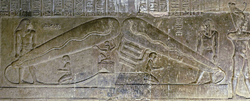
The Dendera Light on the reliefs at the Hathor temple is the fog of microdroplets of the theory
The Dendera Light Bulb / The double outline of the characters offering the cold / The arms and Djed Pillar
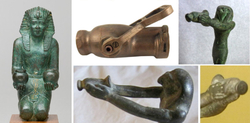
The fog nozzle of the evaporative cooling passage in the Great Pyramid
Horus represented holding the fog nozzle that transformed the pressurized water of the inclined well into a fog of microdroplets, after it had been hit (rammed) by the impactor of the Grand Gallery
Pharaohs represented holding the 2 final products of the Solvay process
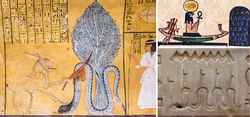
The Great Serpent Apep (Apophis)
The fight between Sun god Ra and Apep / The restraint of the inclined well waters / The equal length cuts of Apep
The 14 Girdle Stones of the Inclined Well / The Dormant Breach and the Draining of the Well

The Khepesh wrenches and the Clamping Rings
The description of the horizontal evaporative cooling passage
The 32 meters collecting ramp

The disc of Sabu as a schist dome shaped and perforated plate that was installed inside counterflow chemical reaction chambers for sodium carbonate and sodium bicarbonate manufacturing into Solvay towers

The impactor of the inclined well
The wooden base of the Ptah-Sokar-Osiris figures
The operating of the grand gallery / The wooden beetle gantry hauling scarab
Poster un commentaire
